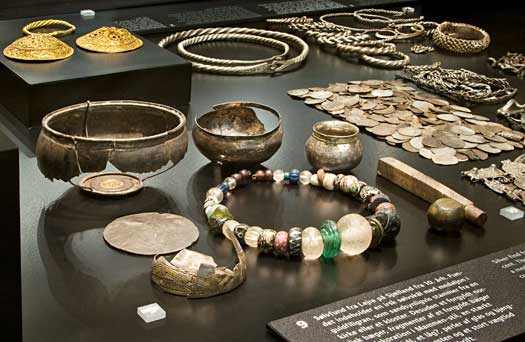What did the Vikings bring back from their travels?
When people travel today they bring many items home with them. These include new clothes, electronics and jewellery, for instance. The Vikings also brought various objects and “souvenirs” back from their travels. There are similarities between the goods brought home by people today and by the Vikings, who also returned with metal objects and jewellery, for instance. The jewellery included the smartest European designs of the time.
Such objects are still recovered today. Jewellery and other metal objects of a Viking date are frequently found by metal detector users throughout Denmark. It is fortunate that metal objects survive to this day. Many of the other products that the Vikings brought home with them, such as objects made of wood and leather, have disintegrated over the years.
Silver from abroad
The activities of the Vikings on the European continent have resulted in significant quantities of Frankish silver being recovered in Denmark. This mostly consists of fittings and belt buckles, which once formed part of military equipment, such as sword mountings and parade harnesses. Such fine equipment presumably originally belonged to the Frankish nobility. Some of these objects have ended up in Denmark, the majority of them perhaps originating from Viking plundering and hostage taking. However, some of the silver objects may also have been given to the Vikings as gifts by the Frankish nobility, either to keep on good terms with them or as payments for mercenary work.
The cup from Fejø
The treasure hoard from Fejø contains a Frankish silver cup and five small cups of Scandinavian origin. The Frankish vessel was made in southern Germany or Austria at the end of the 8th century. It was originally used in church ceremonies. The decoration consists of two friezes, each containing six arches resting on pillars. The upper frieze displays three Christian symbols: the eagle, the lion and the dove. Seen as a whole, the decoration depicts a round building with two floors. The building represents the New Jerusalem as described in the Book of Revelation.
The Ribe cup
The silver hoard from Ribe Nørremark in South Jutland consists of a Frankish silver cup and six small cups of Nordic origin. The Frankish cup was produced in southern Germany or the Alpine region in the decades before 800. It was originally used in church ceremonies.
The Lejre hoard
The hoard from Lejre on Zealand dates to the 900s. It includes an Irish silver bowl with a medallion in gold filigree incorporated into its base. This bowl probably originated from a church or monastery. Other silver items in the hoard include a gilded Nordic cup decorated with four “bird women” and inlaid with niello, fragments of a gilded cup decorated in the Mammen style, a repaired bowl and a lid. In addition, the hoard includes beads of glass and quartz, a whetstone and a weight displaying imitation Arabic script.

